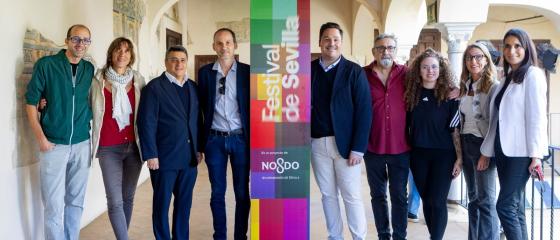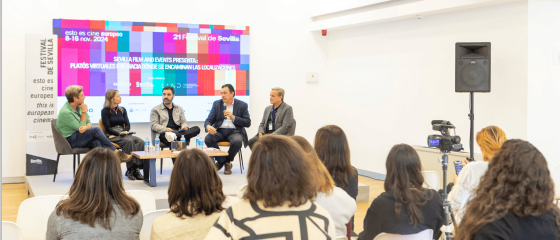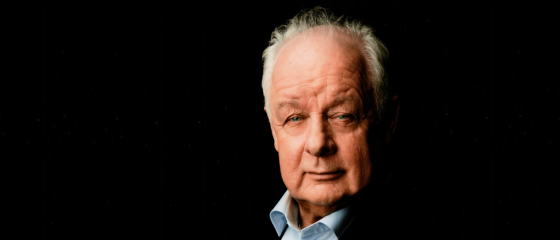"Liborio returns from Heaven to bring the people and raise the dead of this blessed, tearful land of ours". With this warning written on the screen, the story begins, which portrays the figure of Papá Liborio, one of the most revealing in Caribbean history, whose dimension transcended the pure messianic movement, becoming an icon of the peasant struggle, a symbol of hope for a people like the Dominicans, mistreated by colonialism. "He is a curious figure because if you analyse him, inside him you find three characters: Jesus Christ, Che Guevara and Bob Marley", explains director Nino Martínez Sosa, making his debut after a long career as an editor.
The Seville European Film Festival will screen Liborio in the New Waves section. Here are four reasons to run to the cinema and enjoy a stimulating film that is both stimulating and breathtaking in its form.
1. For its fascinating story
"Some saw him as an enemy of progress, a symbol of obscurantism and backwardness, others as the very incarnation of a God who raises the dead and heals with his words, but also as a generator of change, a heroic guerrilla, a symbol of the struggle against imperialism".
Dominican Republic, 1908: legend has it that Olivorio Mateo Ledesma disappeared during a hurricane in San Juan de la Maguana and, several days later, reappeared, according to him reborn from the dead and with a mission ordered by God himself, reconverted into a miraculous healer and prophet. But far from being an enlightened, madman, Papa Liborio, as he was called, wanted a better life for his people, with the revolutionary idea of creating an independent community in the mountains. Liborio spurred his people's resistance: to poverty and hunger, but also to the invader. The growing process of American influence in his country would eventually lead to its occupation. For some, Liborio was a messiah. To others, those in power or those trying to maintain order, such as the contingent of American marines who came looking for him, Liborio was a dangerous revolutionary leader.
2. For its overwhelming visual approach
"The first script was narrative, but the film we wanted to make had more to do with the community than with the character. We wanted to show the myth through the eyes of those who believe in it, to make a multi-faceted portrait that traces the profile of the hero from different points of view. And the film had more to do with the experience than with the mere fact of telling a story. That's when the project began to change and become something much more baroque, as we Caribbean people are. Cinema has to be a path to freedom.
In his first feature film, Nino Martínez Sosa breaks away from any convention associated with the biopic to bring us closer to the figure of Papá Liborio, although the focus is on the relationship he creates with his neighbours, now followers, disciples or worshippers. Martínez Sosa focuses on sensorial stimuli, symbolism and spirituality, without worrying too much about underlining the context or going into encyclopaedic explanations.
It achieves a forceful and expressive use of the environment, the locations, the forests and mountains, the exultant nature, and the cinematography by Spanish cinematographer Óscar Durán. Visually beautiful, hypnotic when showing the ancestral practices of Liborio, forceful without the need to show violence in the killings (although we can hear it, sense it, once again cinema of sensations). A poetic final shot in which two hands interlock ensures the continuity of the resistance movement driven by Papá Liborio.
3. For the subjects it addresses
"Dominican identity is based on the denial of African heritage, it is hispanophile, Eurocentric, and then very pro-American after the invasion. All those things are in the film, notably the specific moment when the Americans invaded the island for the first time. We suffered two invasions in which the land began to be legislated so that it could be sold, in which it went from being a common good to a commodity. The large estates were created, the process of de-peasantisation began, in which the peasants began to migrate little by little towards the urban centres and into the poverty belts, a moment that was like a formative moment; Liborio emerged from all of this".
The approach to the figure of Olivorio Mateo Ledesma, which in the film we meet through the eyes of some of his followers, from their beliefs and from the effect of the messianic character on their lives, goes beyond that. Liborio talks about faith as the backbone of a (in this case a small) society, even as a motor of resistance. But it also speaks of colonialism, of speculation and blood, of the genocides suffered by Latin American countries.
4. For its director
"I always wanted to direct. The editor is a co-writer of the film and is the one who defines the final form. The editing table allows you to define a poetics of language, to know what you like and what you don't like, to see how directors react to certain situations, to talk to them about their fears and their certainties. And it teaches you a lot about the path to renunciation. Leaving behind things you like, ideas that worked before but don't any more. But I've had the urge to direct ever since I started studying film".
Nino Martínez Sosa is making his debut as a director, but he is by no means a newcomer. The 45-year-old Dominican, who settled in Spain after specialising in film editing at the EICTV in San Antonio de los Baños, Cuba. His CV is particularly notable for his work with Jaime Rosales: editing Las horas del día (2003), La soledad (2007), Tiro en la cabeza (2008) and Sueño y silencio (2012). This relationship gave rise to the future collaboration of Liborio with the Spanish director of photography Óscar Durán. Later, Martínez Sosa created the film production company Balsié Guanábana Macuto in the Dominican Republic, which served as a launching pad for his career as a director, and partnered with Fernando Santos and Guasábara Cine to produce Liborio, his first feature film, which before arriving in Seville was presented at the Rotterdam Festival.
Statements gathered from interviews in Caligari, Noticine, Diario Libre and Costa Rica International Film Festival.






